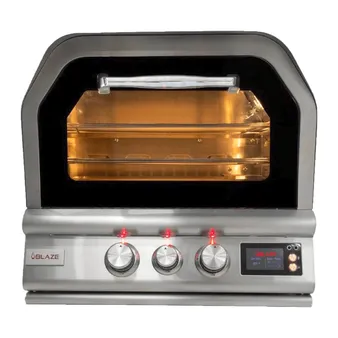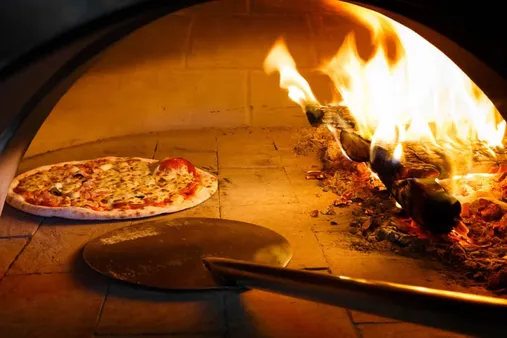Table of Contents
Achieving pizza perfection requires a deep understanding of one crucial element: commercial pizza oven temperature. At tauhuichiban, we're passionate about helping you unlock the secrets to delicious pizza, and that starts with mastering the heat. Whether you're running a bustling pizzeria or simply a pizza enthusiast aiming for restaurant-quality results at home, understanding the nuances of commercial pizza oven temperature is paramount.
Pizza Style | Oven Type | Ideal Temperature | Cooking Time |
|---|---|---|---|
Neapolitan | Wood-fired | 900°F (482°C) | 90 seconds |
New York Style | Commercial Deck Oven | 650-750°F (343-399°C) | 5-7 minutes |
Chicago Deep Dish | Convection Oven | 400°F (204°C) | 20-28 minutes |
Thin Crust | Commercial Conveyor Oven | 500-600°F (260-316°C) | 3-5 minutes |

Unlock The Secrets Of Commercial Pizza Oven Temperature
Understanding Commercial Pizza Oven Temperatures
Imagine your pizza oven is like a dragon breathing fire – the hotter it gets, the better it cooks your pizza! For commercial ovens, the magic number is around 750 degrees Fahrenheit. This intense heat helps cook pizzas super fast, usually in just 3 to 5 minutes. It's like having a race car for cooking pizzas! The key here is to keep that dragon roaring with consistent heat so every pizza comes out perfect.
Pizza Style | Ideal Temperature | Cooking Time |
|---|---|---|
Neapolitan | 900°F (482°C) | "Just a quick sprint!" - about 90 seconds. |
Remember, each style has its own "speed" and "heat level"! |

Understanding Commercial Pizza Oven Temperatures
Factors Affecting Pizza Oven Temperature
Oven Type: The Heart of the Matter
Just like different ovens at home, commercial pizza ovens come in various styles, each with its own personality and quirks. Think of it like choosing a car - you wouldn't use a tiny scooter to haul a bunch of groceries, right? For example, a wood-fired oven, like a roaring furnace, generates intense heat, perfect for those thin-crust Neapolitan pizzas. On the other hand, a deck oven, which is like a flat, heated surface, is ideal for New York-style pizzas. Each oven type has its own temperature range and baking characteristics.
Remember, you wouldn't try to bake a cake in a toaster oven! It's the same with pizza ovens. You need the right oven for the right pizza!
Oven Type | Heat Source | Ideal Temperature |
|---|---|---|
Wood-fired | Burning wood | 800-1000°F (427-538°C) |
Deck Oven | Gas or electric heating elements | 500-750°F (260-399°C) |
Conveyor Oven | Gas or electric heating elements | 450-600°F (232-316°C) |
Pizza Thickness: The Big Picture
Think of pizza thickness as the "scale" of your pizza. A thin-crust pizza is like a delicate butterfly, needing a quick burst of heat to stay crispy. A deep-dish pizza, on the other hand, is like a sturdy bear, requiring a longer, gentler cook to make sure it's cooked through. Thicker pizzas need a lower temperature and longer cooking time to ensure the center is cooked properly, while thin-crust pizzas thrive in a hot oven for a short time.
One time, I tried to make a thin-crust pizza in a low-temperature oven. It turned out like a soggy mess! Lesson learned: match the heat to the pizza!
- Thin-crust pizza: 900°F (482°C) for 90 seconds
- Thick-crust pizza: 400°F (204°C) for 20-28 minutes

Factors Affecting Pizza Oven Temperature
Tips for Achieving Perfect Pizza in Commercial Ovens
Preheating is Key: The Warm-Up
Think of preheating as getting your pizza oven ready for a big game! Just like athletes need time to warm up, your oven needs time to reach its peak temperature. A good preheat ensures even heat distribution, so your pizza cooks evenly and doesn't end up with some parts burnt and others raw. I once forgot to preheat my oven, and my pizza turned out like a soggy mess! It's like trying to bake a cake in a cold oven – not a good idea! A preheated oven is like a warm hug for your pizza, making it happy and delicious. Aim for at least 20 minutes of preheating for optimal results.
Temperature Control: The Pizza Maestro
You're the conductor of the pizza orchestra, and the oven temperature is your baton! You can adjust the heat to create different pizza styles. Remember, thin-crust pizzas need a high heat for a short time, like a quick sprint. Thick-crust pizzas are more like a marathon, needing a lower temperature and longer cooking time. It's like a dance between the heat and the pizza! You can also use a pizza stone or baking steel, which act like heat sponges, ensuring even heat distribution and a crispy crust. Think of it like a warm blanket for your pizza, keeping it cozy and delicious.
Pizza Style | Temperature | Cooking Time |
|---|---|---|
Neapolitan | 900°F (482°C) | 90 seconds |
New York Style | 650-750°F (343-399°C) | 5-7 minutes |
Chicago Deep Dish | 400°F (204°C) | 20-28 minutes |
Thin Crust | 500-600°F (260-316°C) | 3-5 minutes |

Tips for Achieving Perfect Pizza in Commercial Ovens
Final Thought
Mastering the art of pizza-making in a commercial setting hinges on understanding and controlling the oven's temperature. By considering the factors that influence heat, using the right techniques, and prioritizing regular maintenance, you can ensure consistently delicious pizzas with perfect crust and toppings. Remember that practice makes perfect, so keep experimenting and refining your approach to achieve pizza perfection every time.